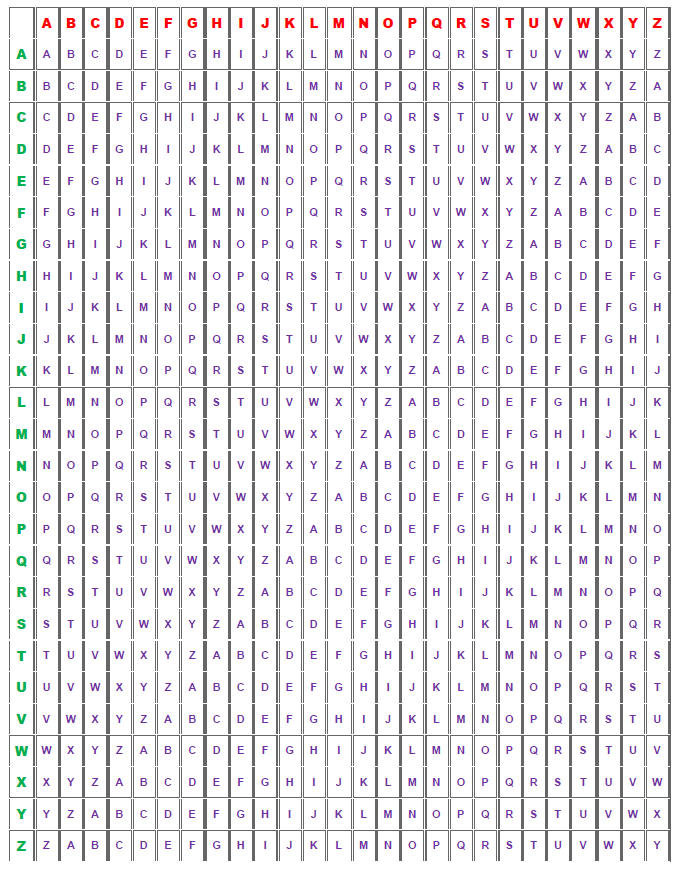

Keywordrepeated = self._get_keyword_repeated(keyword, len(ciphertext))įor index, letter in enumerate(ciphertext):ĭecipheredletter = chr((letter) + 65) # encipheredletter = chr(((plaintextindex + keywordindex) % 26) + 65)ĭecrypts the ciphetext using the keyword. Keywordindex = ord(keywordrepeated) - 65Įncipheredletter = self.tabularecta Plaintextindex = ord(letter.upper()) - 65 Keywordrepeated = self._get_keyword_repeated(keyword, len(plaintext))įor index, letter in enumerate(plaintext): Plaintext = self._process_plaintext(plaintext) Only the letters a-z and A-Z will be included The plaintext argument can be any string, but Self.tabularecta = self._create_tabula_recta() This class provides methods for enciphering andĭeciphering text using the Vigenere cipher.
Vigenere cipher code#
You can download the source code as a zip or clone/download from Github if you prefer. This project consists of the following two Python files.

I will implement the Vigenère Cipher as a class with two methods, one to encipher and one to decipher. The actual encipherement/decipherement can be carried out in just one line of code whether you are using a table or algebra so I will implement both methods which you can try out by commenting/uncommenting the relevant lines.
Vigenere cipher mod#
It uses zero-based alphabet to integer mappings, so A = 0, B = 1 etc., an easy concept for any programmer to understand!Įnciphered index = (plaintext index + keyword index) mod 26įor the first letter of the example I = 8 and O = 14 so:Įnciphered index = (8 + 14) mod 26 = 22 = WĪlgebraic decipherement uses the formula:ĭeciphered index = (enciphered index - keyword index) mod 26Įnciphered index = (22 - 14) mod 26 = 8 = I There is also an algebraic method of enciphering/deciphering with the Vigenère Cipher which does not need a Tabula Recta. To decipher the text we just reverse the process: go to the row for the corresponding keyword letter, search along to find the enciphered letter, and then take the letter at that column's heading. The second I is paired with E, so is enciphered as M. If we find the plaintext letter along the top of the Tabula Recta, the keyword letter along the left side, the letter where the column and row meet is used to encipher that particular instance of the plaintext letter.įor example, the first letter of the plaintext is I and its keyword letter is O, and they intersect at W. Using the examples mentioned this gives us the following plaintext and keyword:Įach letter in the plaintext now has a corresponding letter in the keyword. The keyword is then repeated to create a string the same length as the plaintext. The plaintext is stripped of all characters except the letters a-z and A-Z, and then converted to upper case. For this example I will use " Imagination is more important than knowledge." as plaintext and " orchestra" as a keyword. This can be anything but ideally should be of a reasonable length. To encipher a string of text you need a keyword. The processes of both encipherement and decipherement involve the use of a table of letters, variously know as a Vigenère Square, Vigenère Table of Tabula Recta, which looks like this.

Vigenere cipher crack#
It may even be encrypted as itself which the famous German WW2 Enigma machine could not do, providing the Allies with a way to crack the code. The Vigenère Cipher is more sophisticated in that a letter may be encrypted as any other letter depending on its position in the plaintext. The problem with the Caesar Shift Cipher is that each letter is always enciphered the same way, so for example if E, the most common letter, is always enciphered as S then simple frequency analysis will reveal the shift if you have a reasonably long piece of encrypted text.
Vigenere cipher full#
If you want to read up on it in full check out the Wikipedia article It was not broken until 1863 although these days it is highly insecure and is now only useful as an interesting programming exercise. The Vigenère Cipher was invented in 1553 by the Italian Giovan Battista Bellaso but is now erroniously named after the Frenchman Blaise de Vigenère. I will now expand on the theme by implementing the Vigenère Cipher. A while ago I wrote a post on implementing the Caesar Shift Cipher in Python.


 0 kommentar(er)
0 kommentar(er)
